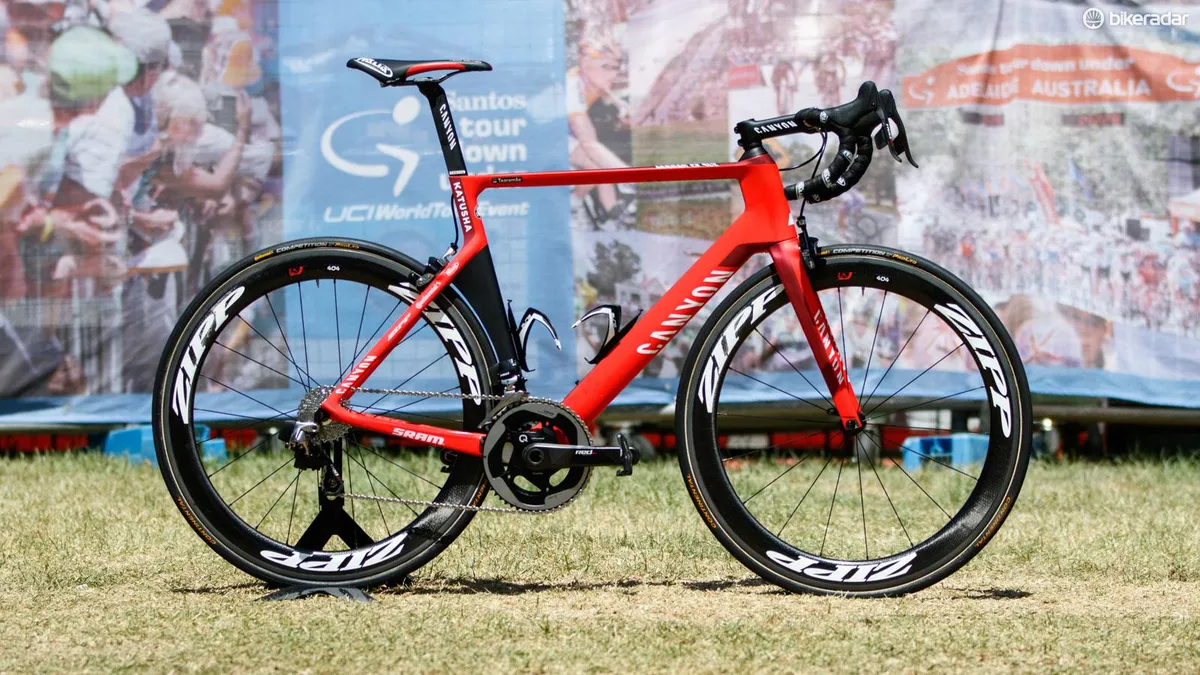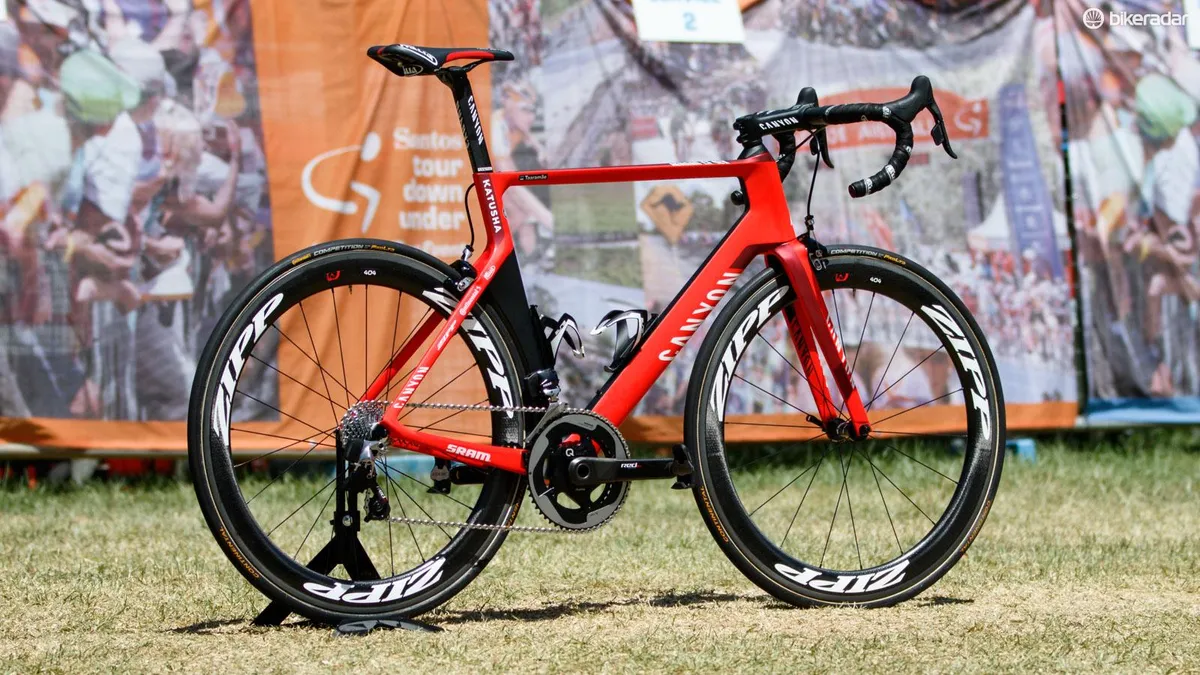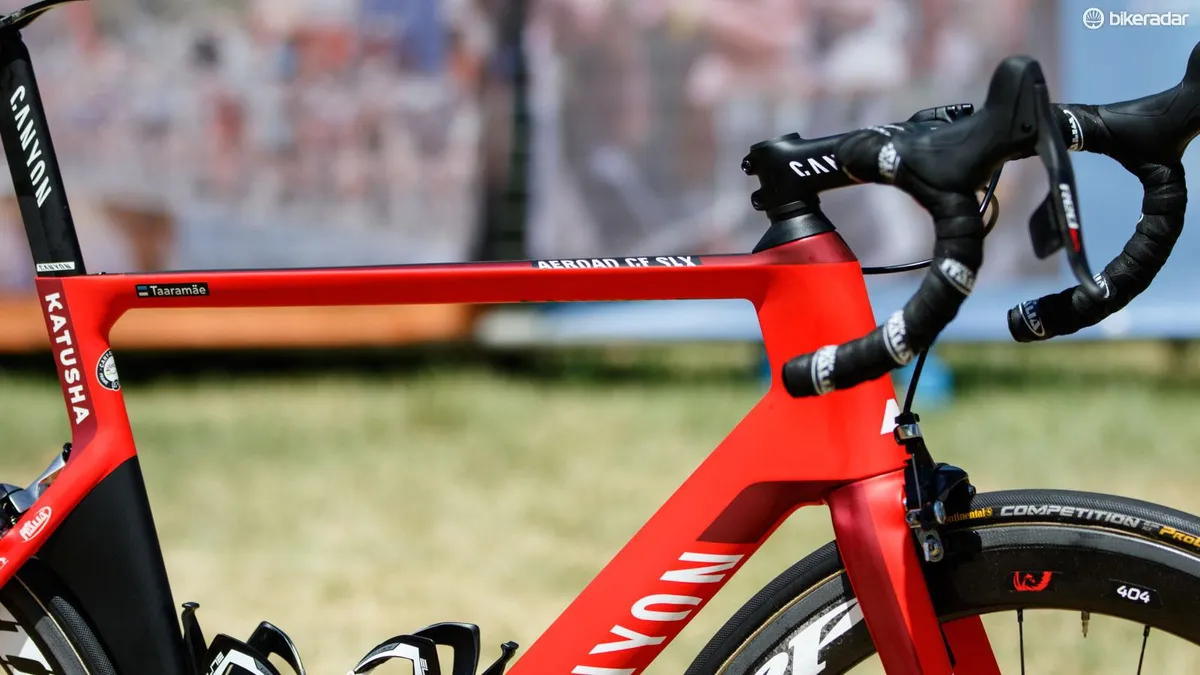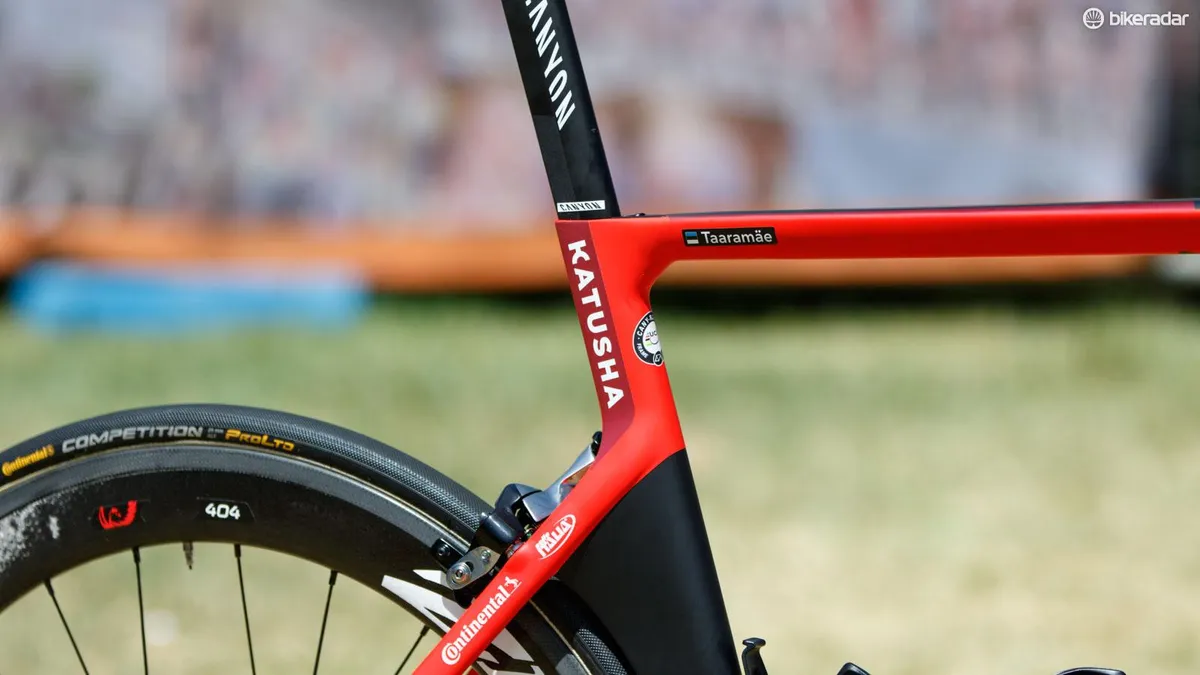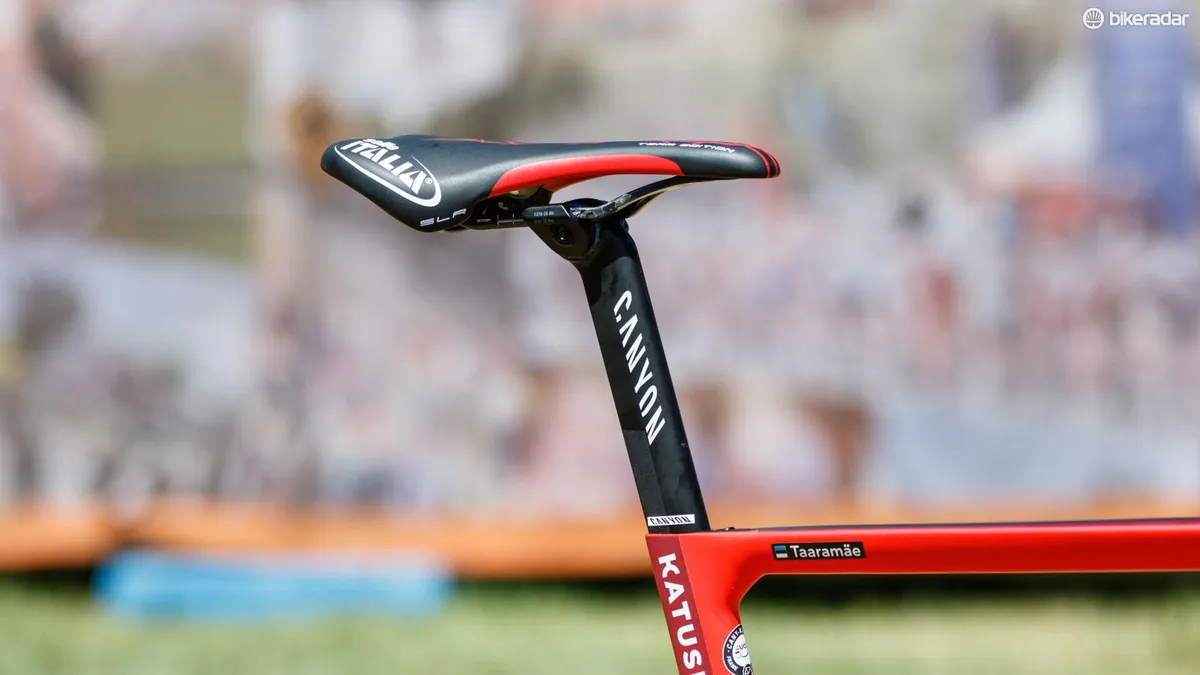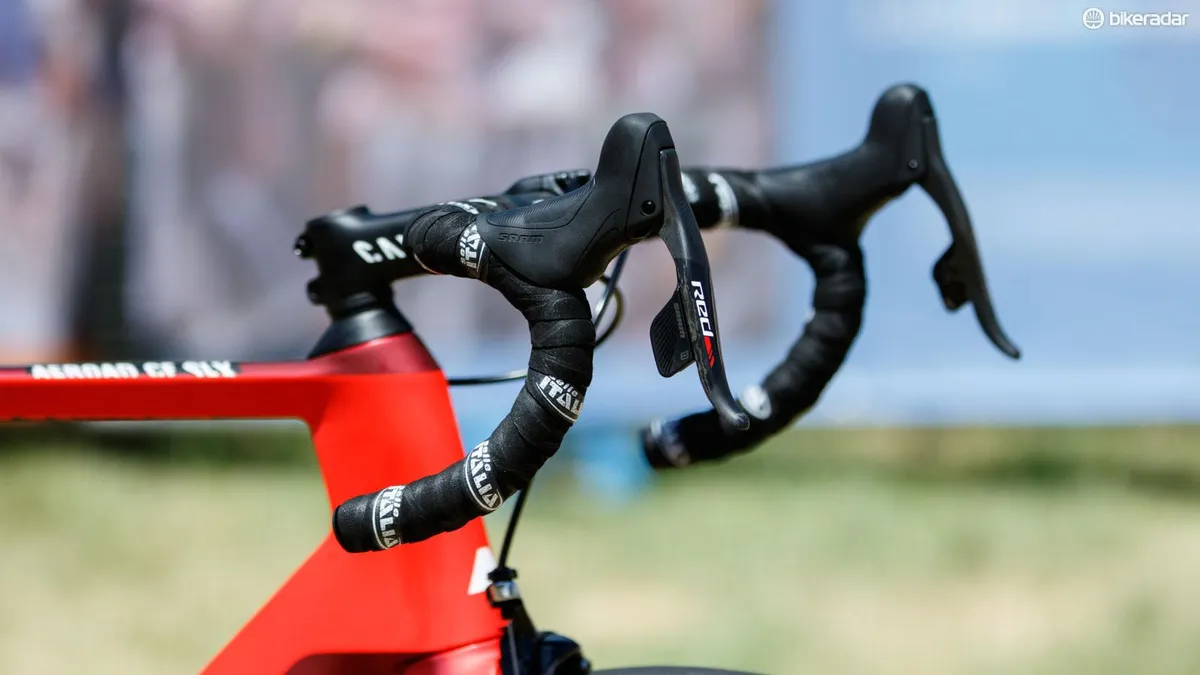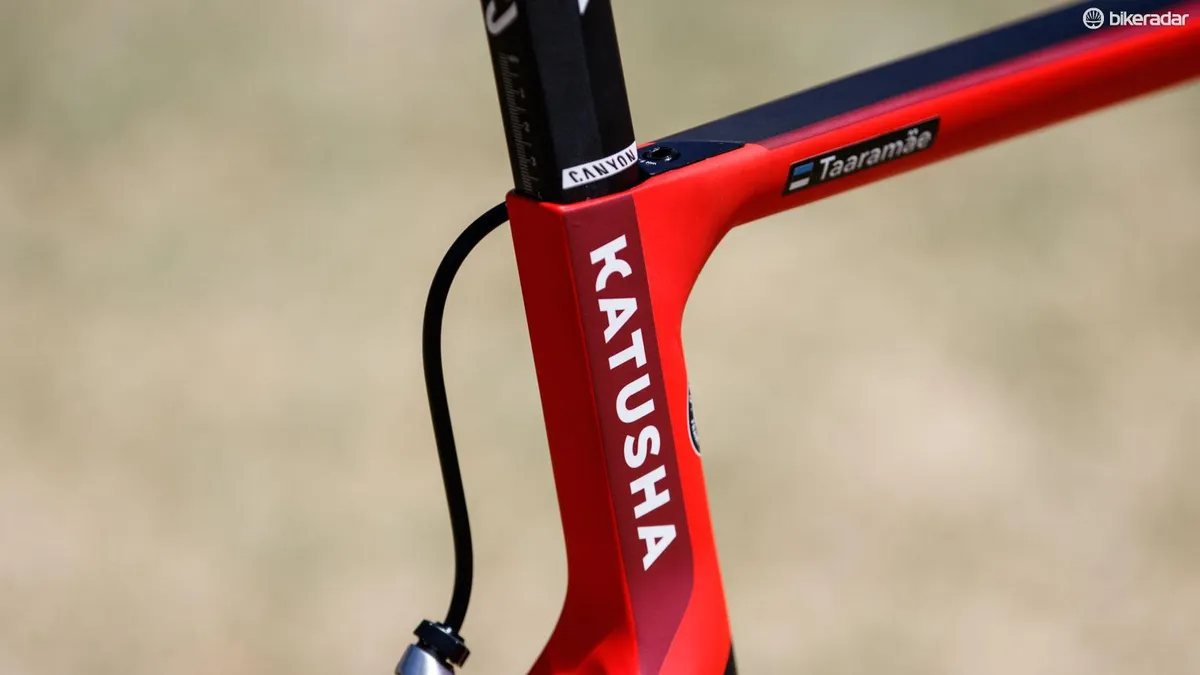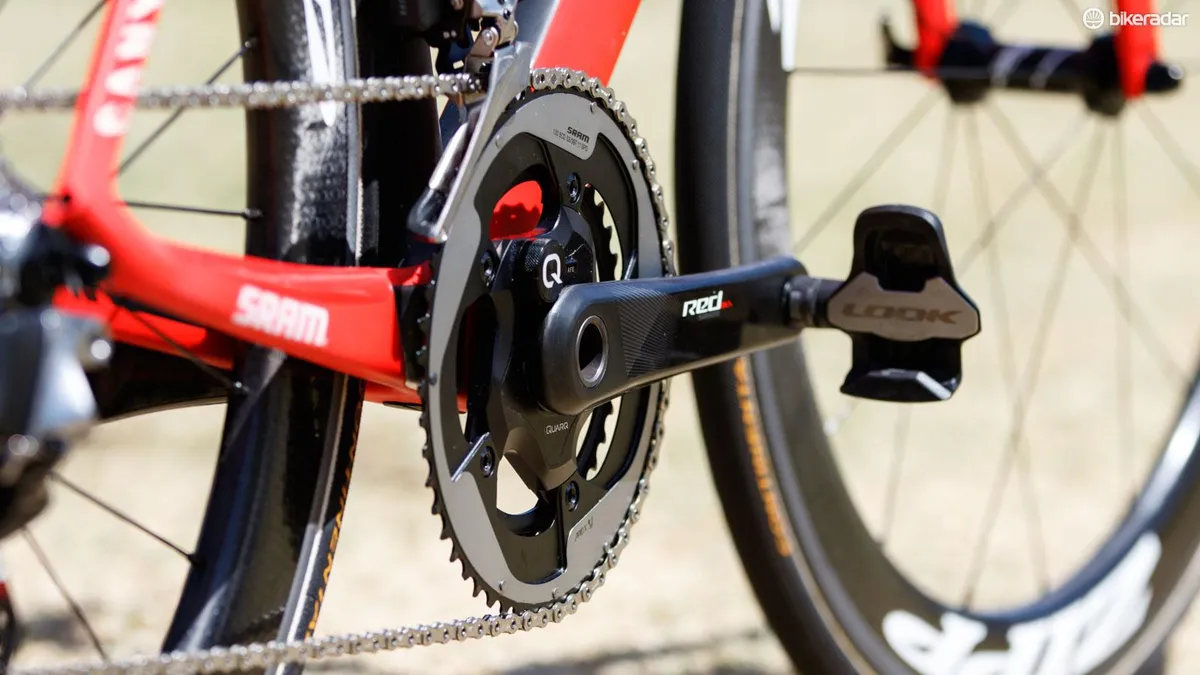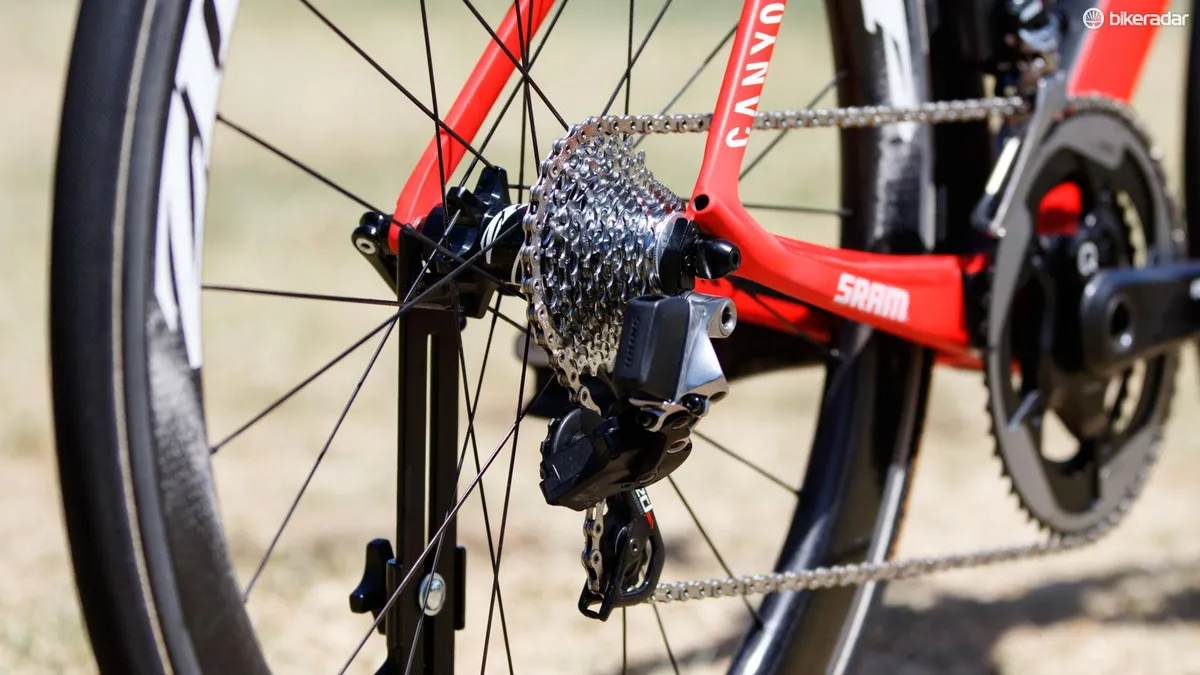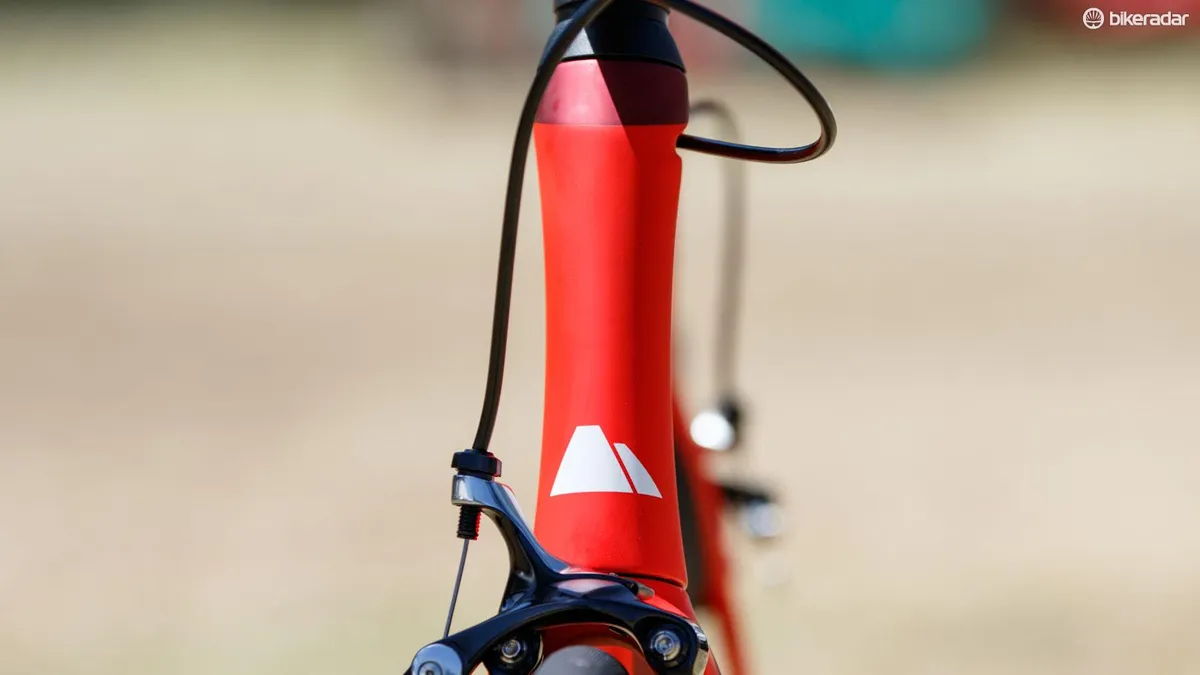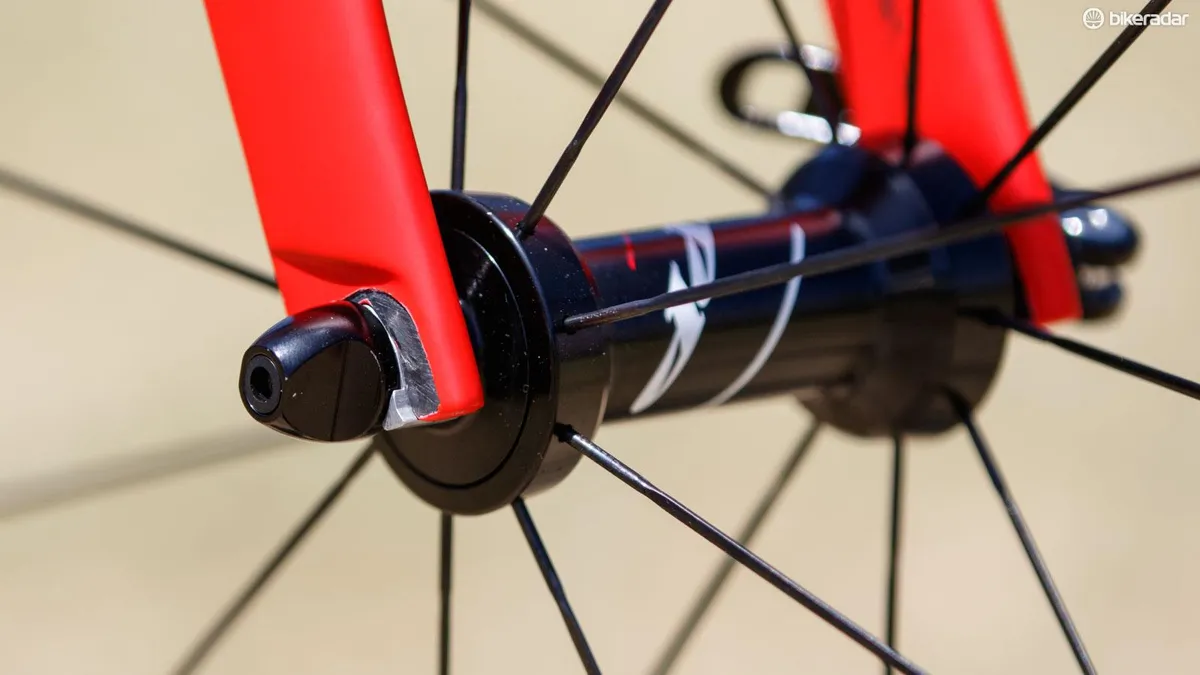A pro since he was 20, the now 28 year-old Rein Taaramäe is a multiple road and time trial champion of his home country – Estonia. Much of Taaramäe’s professional cycling career was spent riding for Cofidis, and in that time he collected plenty of victories and podiums, but perhaps none bigger than his 2011 stage win at the Vuelta a España.
Riding for Astana in 2015, Taaramäe won both the Arctic Race of Norway and Vuelta a Burgos. Switching things up for 2016, the Estonian rider joins the Russian outfit Katusha – which recently avoided a ban despite two riders testing positive for prohibited substances over a 12-month period – on a one-year contract.
Much as Taaramäe is new to the Canyon-sponsored team in red, so is American component-powerhouse SRAM. Last year, Ag2R was the only WorldTour team on SRAM components, and now Katusha makes that two.
For the 2015 season, we speculated that SRAM had taken some time out of its previously intensive sponsorships while it perfected its eTap wireless shifting group. The company strongly disputed such claims at the time, but it seems there may have been some truth to our conjecture after all.
The house of SRAM also includes the global brands of Zipp and Quarq, and such a sponsorship sees these components supplied too. This covers power meters and wheelsets only, and the American sponsorship doesn’t extend to cockpit components. That’s an area Canyon not only takes care of, but is actively expanding in.
Aero + road = Aeroad
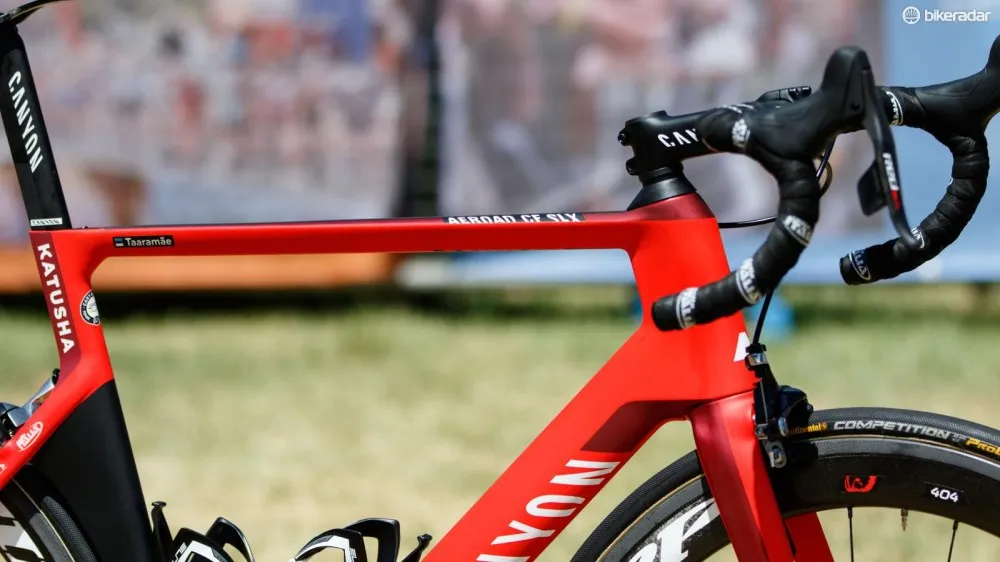
Built to go fast, the Aeroad CF SLX
Canyon’s current generation of the Aeroad CF SLX aero road bike was first launched at the 2014 Tour de France. It’s a frame designed to be fast over a range of ‘average’ yaw angles, as opposed to seeking an all-out class leading number in just one plane.
The key tubes feature blunt back edges for similar aerodynamic benefits as commonly used Kammtail designs, although Canyon its profiles are different.
Related reading: Canyon Aeroad CF SLX 9.0 SL ridden and rated
Stating it doesn’t really affect wind-tunnel numbers, Canyon kept the direct-mount rim brakes in a traditional (and easy to adjust) placement. To reduce the profile, front-specific brake calipers are used at both ends of the bike.
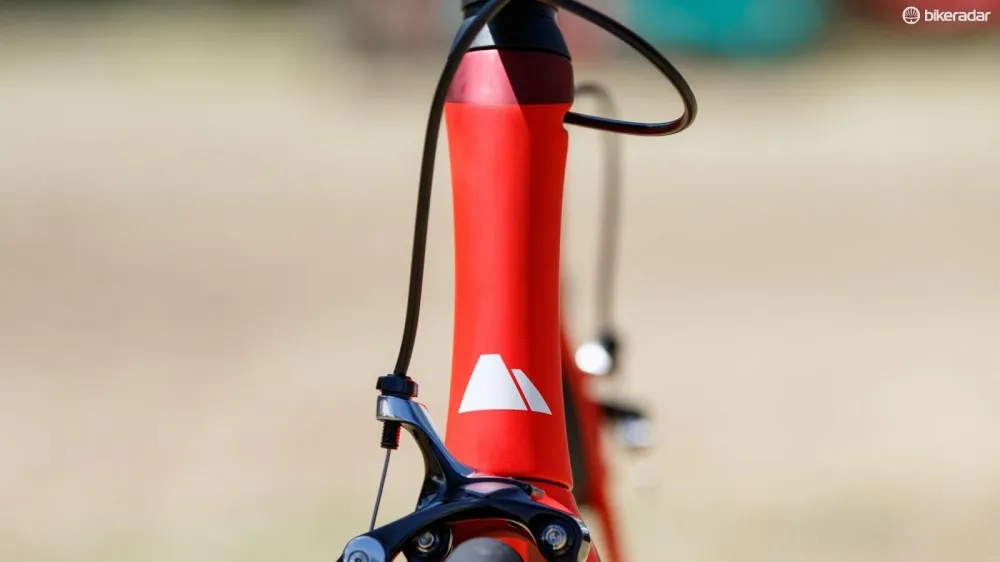
There's an oversized 1 1/4in steerer tube in there (standard is 1 1/8in), but you wouldn't know it
The Aeroad’s frame stiffness figures are rather impressive, with a large down tube and oversized 1 1/4in fork steerer taking much of the applause here. Canyon has taken an extra step to overcome the additional girth of that wider steerer tube, and so the headset bearings are slimmer than normal.
Ready for flight, Canyon at the cockpit
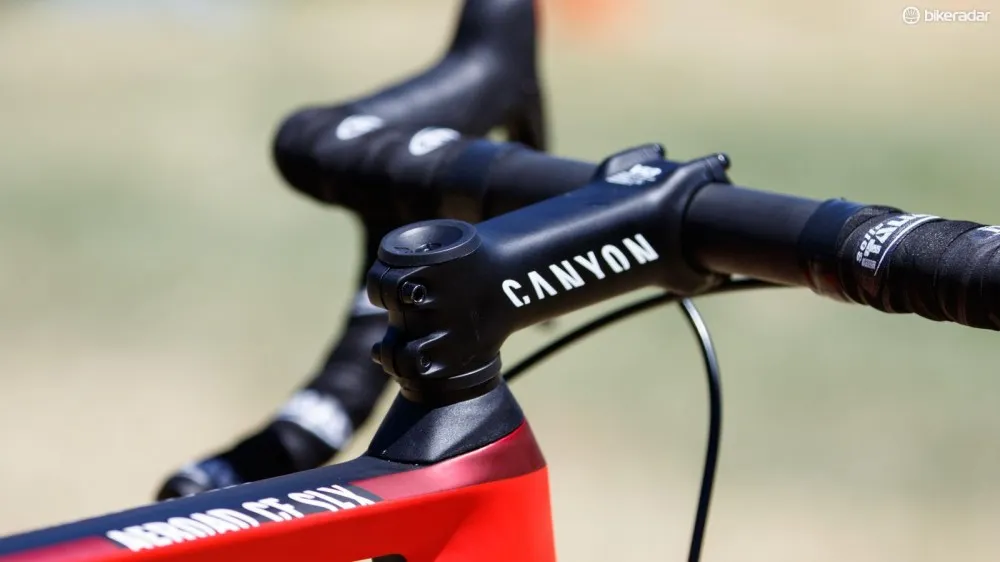
Canyon has invested in its own cockpit components, engineered in Germany
Recent years have seen the German engineers at Canyon busy creating a range of cockpit components that deserve their well-respected branding. A good example is the monocoque Aerocockpit CF integrated stem and handlebar, an item used on both the Aeroad CF SLX 9 and newer Ultimate CF SLX 9 Aero.
In a similar story to the XXX bar on Trek’s new Madone, this one-piece handlebar setup plays a big part of Canyon’s aero claims. In fact, the German consumer-direct brand claims this bar setup earns a 5.5W advantage compared with a more traditional two-piece bar and stem setup.
Use of such an integrated bar is quite common among the Canyon sponsored teams, including the new women’s Canyon//SRAM bikes, although it’s not always possible when riders seek more specific fitment.
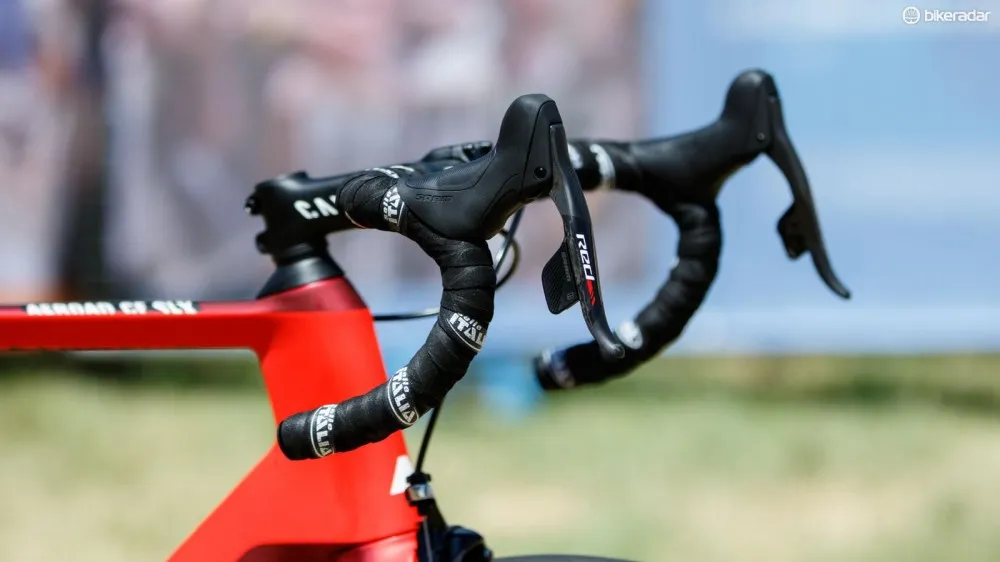
Bars rolled backward is a likely reason for Taaramäe not using an integrated handlebar etup
This is likely the reason for Taaramäe’s use of a more traditional stem and handlebar setup. Such a thing allows Taaramäe to roll the bars back slightly and be more specific about drop shape choice too.
Wires at the brakes only
Joining the likes of Ag2R and the new Canyon//SRAM women’s team, Katusha are now riding SRAM’s new wireless eTap gearing.

SRAM's eTap also brought in a graphic change for other continuing components, such as the cranks
The wireless components consist of new derailleurs and shifter/brake levers. The brake calipers, crankset, chain and cassette continue over from SRAM Red 22 groupset, albeit with some minor graphic refreshments to best match the cleaner-looking eTap.
The new shifting style has likely taken a bit of getting used to for the riders who are coming off of Shimano Dura-Ace Di2 drivetrains from last season. For Taaramäe, it’s possibly an even bigger adjustment having come from the thumb and finger shifting of Campagnolo EPS.
It’s a simple setup in the case of Taaramäe’s bike, with no sign of additional ‘Blip’ shifters (optional plug-in buttons for shifting from either the handlebar drops or tops).
- Related reading: SRAM eTap is launched
- Related reading: SRAM eTap first ride review
- Related reading: SRAM eTap install and actual weights
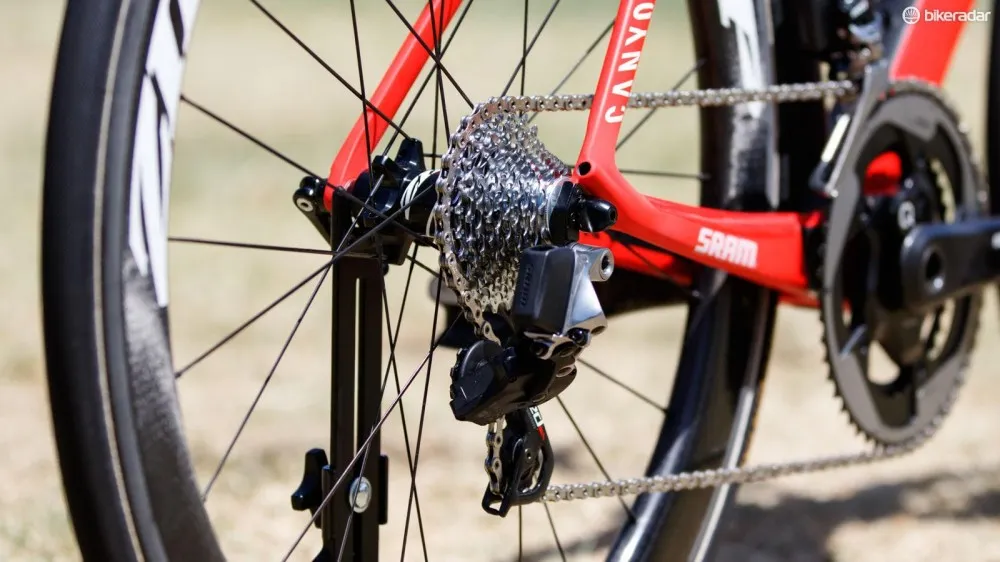
Clearly this is not a wireless-specific frame, but it is designed for electronic drivetrains
Where many brands now do one frame that can handle mechanical and electronic shifting, Canyon still does it a little differently. The Aeroad frame is available in either a mechanical or electronic configuration, with specific cable ports in each. For the case of this Katusha bike, it’s a standard Aeroad CF SLX ‘El’ frame built for Di2 and EPS shifting, but with the minimal electronic ports unused.
For the brakes, the Shimano Dura-Ace calipers stand out for a SRAM sponsored team. As previously reported from the Tour Down Under, this is due to SRAM currently not offering direct-mount road brake calipers and therefore the team has simply picked the best available.

The Estonian rider has his saddle slammed rearward
The Selle Italia saddle of choice appears to be a hybrid of models currently offered by the Italian company. Here, Taaramäe is using a 131mm width SLR ‘Team Edition’ saddle, but with what’s likely a ‘Kit Carbonio’ base and rails for further weight savings.
With the move away from Shimano, an easily overlooked aspect is the change of pedal systems. SRAM doesn’t offer its own pedals and so sponsored teams can then choose between popular non-Shimano choices of Look, Speedplay and Time systems.
For Taaramäe, Katusha’s move to Look pedals in 2016 is likely a blessing, having used the same pedal while at Astana the year before. However, existing riders may be going through a steep adaption curve with changing out such a major contact point. During the Tour Down Under, we saw at least one rider fiddling with this cleat position after the stage.
One odd point is the lack of a computer mount on this ride. Normally we wouldn’t think too much of it, but the addition of a SRAM ‘eTap’ Quarq power meter makes this a peculiar exclusion. While the photos we took didn’t show one, race photos of Taaramäe clearly show a Garmin Edge 520 in use out the front of his bars.
Complete bike specifications
- Frame: Canyon Aeroad CF SLX, size large
- Fork: Canyon Aeroblade SLX
- Headset: Acros, Canyon
- Stem: Canyon V13, 120mm x -6 degree, 1 1/4in steerer
- Handlebar: Canyon H32 Ergo CF, 42cm width
- Tape: Selle Italia Smootape Gran Fondo
- Front brake: Shimano Dura-Ace 9010
- Rear brake: Shimano Dura-Ace 9010
- Brake levers: SRAM eTap
- Front derailleur: SRAM eTap wireless
- Rear derailleur: SRAM eTap wireless
- Shift levers: SRAM eTap wireless
- Cassette: SRAM X-Glide 1190, 11-28T
- Chain: SRAM RED 22
- Crankset: SRAM eTap Quarq power meter, GXP, 175mm, 53/39T
- Bottom bracket: SRAM GXP pressfit
- Pedals: Look Keo Blade 2 CroMo
- Wheelset: Zipp 404 Firecrest tubular
- Front tyre: Continental Competition, 25mm
- Rear tyre: Continental Competition, 25mm
- Saddle: Selle Italia SLR ‘Team Edition’ Carbonio
- Seatpost: Canyon S27 Aero VCLS CF
- Bottle cages: Elite Custom Race (2)
- Computer: Garmin Edge 520 (not pictured)
Critical measurements
- Rider's height: 1.84m (6ft)
- Rider's weight: 67kg (148lb)
- Saddle height from BB, c-t: 780mm
- Seat tube length, c-t: 551mm
- Saddle setback: 84mm
- Tip of saddle to centre of bar: 610mm
- Saddle-to-bar drop: 100mm
- Head tube length: 167mm
- Top tube length (effective): 572mm
- Total bicycle weight: 7.28kg (16.05lb) (computer not included)
For more tech coverage from the 2016 Tour Down Under, click here.
